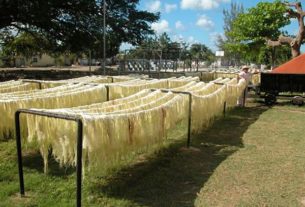Not too long ago a friend loaned me all six of these wonderful books for me to browse through. I have to admit that Mexican Country Style, The New Hacienda, Casa Adobe, Adobe Details, Casa Yucatan and Mexican Details hit a real soft spot because I’m an ardent admirer of Mexican creativity as it exhibits itself so lavishly in art, architecture, the design of everyday objects and the bold approach to color. And I particularly enjoy good photographic books, which these essentially are.
Authors Witynski and Carr are the owners of Texture Antiques in Austin, Texas, an interior design firm specializing in Mexican colonial furniture and antiques. They also write for a number of design publications. In addition, Karen Witynski has taken most of the hundreds of gorgeous photographs you’ll find throughout these six volumes.
Witynski and Carr have obviously visited many, many homes and other types of establishments throughout the U.S. Southwest and Mexico, well down into Yucatán and they’ve found some breathtaking outdoor and indoor living spaces.
These are mostly large format volumes of the type usually called “coffee table books”. A couple of them are in softcover format. Each one follows a particular theme, inherent in the title.
As Mexican Country Style states: “Authors Witynski and Carr have spent years wending their way by bus and even on burros through coastal villages and colonial mining towns in search of simple, robust country tables, corral gates and old heavy doors. They’ve emerged from their travels with a fabulous collection of objects and artifacts, many of which have found their way into the homes and offices of people like Jane Fonda, Gene Hackman, Nelson Rockefeller and Ted Turner.”
A particularly useful feature of this book, apart from the wonderful photos, is a detailed chapter on buying and restoring the objects one finds on these exploratory tours of the country. There’s ample discussion of the various types of wood in these artifacts and of the variety of finishes that are used on them. In that sense, it’s a completely practical manual for anyone interested in following in the authors’ footsteps, searching out and restoring found objects. At the same time, the examples of how the objects are used in modern day homes are abundant.
In The New Hacienda Witynski and Carr show that they’ve visited a lot of old haciendas in their twenty years of journeying through Mexico. It’s very much a “how-to” book in that there’s a great deal here about the restoration of rundown properties, again with ample photographic illustration.
As they write: “Over the last five years, we have witnessed a widespread preservation movement that has gained great momentum in Mexico, stimulating a revival of traditional construction techniques – from carved stone, adobe, and bóvedas (vaulted ceilings), to tapial (rammed earth) and stucco textures enhanced by the use of cactus juice.”
Following the Mexican Revolution of 1910, many haciendas were abandoned or left to decay, suspended between a past memory and an unknown future. Today, these architectural treasures have been rediscovered by a new generation of international designers, architects and preservationists.
And here, in this one volume, is a valuable record of this process of rediscovery and renewal, amply illustrated by more of those lovely photos, punctuated with a good deal of practical advice.
Casa Adobe is a tribute to an old tradition that still has a future. I can’t do any better than quote from the introduction: “From rugged thick-walled haciendas in Mexico to a Texas fort-turned-luxury ranch and a Cuernavaca spa retreat, the seductions of adobe dwellings are many – sculptured walls with contoured corners and softly flowing lines; fireplaces that replaced traditional corners with warmth and grace; carved nichos for displaying artworks; ceilings of hearty exposed vigas; earthen floors hand-troweled to a smooth finish; hand-carved Mexican doors; gleaming Saltillo tiles; stone-paved courtyards, stepped walls that hide reflecting pools; and breezy portales that welcome the outdoors.”
And, again, there’s that generous supply of first-class photos to illustrate all those ways in which adobe is used. I really liked the intimate looks at all those houses, both in Mexico and in the Southwest U.S. and the imaginative ways in which they are designed – either in traditional or modern style.
Adobe Details carries on in the same vein, paying tribute to the myriad ways in which adobe homes are decorated, in styles both traditional and modern.
For their next book, Casa Yucatán, the pair journeyed to the Yucatán Peninsula where a new generation of architects is working to create new styles that merge with traditional Mayan and Spanish colonial building. The photos in the chapter on Coastal Homes just makes you want to reach for your swimsuit and find the fastest way down there.
Carr and Witynski sound as though they have a sizeable investment in that area. They’re partners in the design and restoration of Hacienda Petac, an 18th century Yucatán estate.
In their sixth book, Mexican Details, they feature the smaller articulos in which Mexican design exhibits itself, such as baskets, wall hangings, masks, religious objects, pictures, bowls, kitchenware, table settings, etc..
It’s yet another handsome tribute to the abundant creativity one finds in this constantly surprising country.
In my humble O:It must be obvious that I’m extremely impressed with all of these volumes. And I realize that you’re not going to rush out and invest in six large format coffee table books. But at least look in a bookstore or two and try to check them out. They’re well worth your time.
Mexican Country Style, 1997 (Softcover)
The New Hacienda, 1999 (Softcover)
Casa Adobe, 2001
Adobe Details, 2002
Casa Yucatán, 2002
and
Mexican Details, 2003
By Karen Witynski and Joe P. Carr
Gibbs Smith, Publisher
Available from Amazon Books: Paperback

